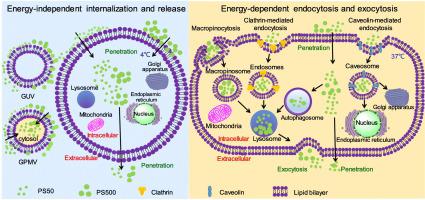Science of the Total Environment ( IF 8.2 ) Pub Date : 2021-03-18 , DOI: 10.1016/j.scitotenv.2021.146523 Ling Liu , Kexin Xu , Bowen Zhang , Yiyuan Ye , Qiu Zhang , Wei Jiang

|
Microplastics and nanoplastics can accumulate in organisms after being ingested, be transported in the food web, and ultimately threaten human health. An understanding of the cellular internalization and release of micro(nano)plastics is important to predict their cytotoxicity. In this study, 50 nm, 500 nm and 5 μm polystyrene particles (PS50, PS500 and PS5000) were exposed to both model cell membranes and rat basophilic leukemia (RBL-2H3) cells. PS50 and PS500 absorb on the model membrane due to hydrophobic interactions and Van der Waals’ forces, and may also penetrate the model membrane. PS50 and PS500 are internalized into living cells via both passive membrane penetration and active endocytosis. The passive membrane penetration is due to the partition of polystyrene particles in the water-phospholipid system. The endocytosis of PS50 occurs through the clathrin-mediated pathway, the caveolin-mediated pathway and macropinocytosis, but endocytosis of PS500 is mainly via the macropinocytosis. PS5000 cannot adhere to the cell membrane or be internalized into cells due to its large size and weak Brownian motion. The endocytosed PS50 and PS500 mainly accumulate in the lysosomes. The passively internalized PS50 and PS500 initially distribute in the cytoplasm not in lysosomes, but are transported to lysosomes with energy supply. PS50 and PS500 are excreted from cells via energy-free penetration and energy-dependent lysosomal exocytosis. The masses of the internalized PS50 inside the cells and the excreted PS50 outside the cells were both higher than the masses of PS500, indicating that the smaller particles are more easily enter or leave cells than do their larger counterparts. Our findings will contribute to the risk assessment of micro(nano)plastics and their safe application.
中文翻译:

聚苯乙烯微塑料和纳米塑料的细胞内在化和释放
摄入后,微塑料和纳米塑料会在生物体中积累,在食物网中运输,最终威胁人类健康。了解微(纳米)塑料的细胞内在化和释放对于预测其细胞毒性非常重要。在这项研究中,将50 nm,500 nm和5μm的聚苯乙烯颗粒(PS50,PS500和PS5000)暴露于模型细胞膜和大鼠嗜碱性白血病(RBL-2H3)细胞。由于疏水相互作用和范德华力,PS50和PS500在模型膜上吸收,并且也可能穿透模型膜。PS50和PS500通过被动膜渗透和主动内吞作用被内化到活细胞中。膜的被动渗透是由于聚苯乙烯颗粒在水-磷脂系统中的分配。PS50的内吞作用通过网格蛋白介导的途径,小窝蛋白介导的途径和巨胞饮作用发生,但PS500的胞吞作用主要通过巨胞饮作用。PS5000尺寸大且布朗运动弱,因此无法粘附到细胞膜或内化到细胞中。内吞的PS50和PS500主要积聚在溶酶体中。被动内化的PS50和PS500最初不在溶酶体中分布在细胞质中,而是通过能量供应转运到溶酶体中。PS50和PS500通过无能量渗透和依赖能量的溶酶体胞吐作用从细胞中排出。细胞内部的PS50内在质量和细胞外部排出的PS50的质量均高于PS500的质量,表明较小的粒子比较大的粒子更容易进入或离开细胞。我们的发现将有助于微(纳米)塑料的风险评估及其安全应用。


















































 京公网安备 11010802027423号
京公网安备 11010802027423号